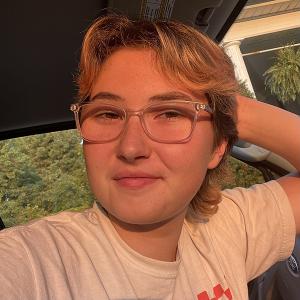Building a magazine from the ground up
March 20, 2010
Sam Jewler ’10
It is hard to leave behind an era of your life in which you grew immeasurably. But it inevitably becomes necessary, as it will be in graduating college and in life's continuously unforeseeable vagaries--and it is often for the best.
That's what I was thinking as I spent weeks mulling over the thought of leaving the Oberlin Review, where I first discovered journalism, the passion of my life. The Review was the encouraging hand that first shoved me off into the world (or campus) to report on a story, despite having no serious journalism or writing background to speak of. The newspaper was essentially what I devoted my life to from the time I discovered it midway through sophomore year, spending countless hours every week researching and reporting on stories, hanging out in the office, brainstorming new story ideas, peering wide-eyed over editors' shoulders, and dreaming of the day when I would be in their shoes.
The semester after I joined, my life took another great leap when I was hired to be Commentary editor of the paper. I began to model my op-eds as best I could on those of Frank Rich, and spent the semester chasing down writers and cartoonists, and editing and laying out three- and four-page spreads every week. The nights of editing and production became routine marathon sessions--it was normal for me to spend upwards of six hours in the office on both Wednesday and Thursday nights. One time, when I put together a seven-page section for our special 2008 Election edition, the copy editors found me in the office at 7am Friday morning, bleary-eyed but proud.
The next semester I was promoted to News editor, which charged me and my two fellow News editors with covering all the news of the week on campus and in the community. It can be hard, holding truth to power and getting it right. One time the union that represents most of the College staff threatened to strike. I talked with all kinds of union workers--janitors, mechanics and cafeteria workers--but the administration understandably declined to talk, given the delicacy of the ongoing negotiations. The challenge, therefore, was to cover the story accurately despite only having one side's opinion. I thought I did a pretty decent job, but let's just say the administration was not happy with our editors-in-chief.
Regardless, I learned from that experience and many more. I came to the Review as a sophomore desperate for something to inspire him, and I left as a senior who believes he knows what his calling is. Besides the union issues, I covered executive pay, town-gown tensions, a student raising money to build a school in Zaire (my first article ever), the renovation of our beloved Apollo movie theater, Oberlin's Coca-Cola ban, the story behind our "fearless" slogan, the troubled climax of Oberlin's beloved Drag Ball, and countless other stories. I interviewed New York Times op-ed legend Frank Rich (not up online right now), Star Trek actor and Oberlin alum Avery Brooks, rapper and social activist Immortal Technique, Ohio Lieutenant Governor and Oberlin alum Lee Fisher, and other interesting people. I also unleashed my opinions in op-eds about national and campus issues.
But the time came for change, as it always does. Call it burnout, call it restlessness--either way it was a tough choice, but one I had to make.
Fortunately, I was blessed with a perfect storm of opportunity. Around the time I was considering leaving the Review, one of my housemates approached me about working on a new environmental magazine she was founding with a classmate. I was very intrigued. The more I thought about it, the more I realized that my creative juices yearned for the monthly magazine format. It would give me time to deeply investigate stories, and would remove the harness of strict newspaper objectivity.
And about four months later, our baby has hit the stands! It has been a continuous labor of love &mdash securing enough funding, recruiting writers, writing and editing stories, and generally learning how to work together to build a quality publication with no institutional foundation. Fortunately for us, Oberlin makes it easy to find funding for projects that you're serious about accomplishing. The Student Finance Committee, which is run by students and draws its funds from the student activity fee tacked on to every student's tuition, was quite generous in granting us enough money to print 300 copies of each issue. But we wanted to print 500, so we turned to other sympathetic groups—the EnviroAlums, the Office of Sustainability, Village Housing—for the rest. As for recruiting writers, it has been a bit of a struggle so far. Though Oberlin does not lack for environmentalists and talented writers, many students end up finding themselves so busy that they don't feel they can take on another responsibility. But the writers we have are great, and with growing name recognition on campus we hope to attract more.
Our very first issue featured an array of relevant stories. In light of a campus debate over whether Oberlin should stop selling bottled water, I wrote a cover story on the environmental and human health impacts of using disposable water bottles. We also had a detailed story on the pros and cons of some of the College's future clean energy options, specifically biomass and natural gas, written by Julia Nakad, co-editor-in-chief and the housemate that recruited me. Our layout editor and co-editor-in-chief, Erika Zarowin, wrote an interesting story on a movement in West Virginia to save a mountain from being blown up and mined for coal to being salvaged for its great wind power potential. Our Managing Editor Eliza Haburay-Herrling wrote an important story on the economic and political destruction that befell our local bus company, Lorain County Transit. Other compelling content includes a case study looking at what we can learn from the success of Middlebury College's biomass facility, a protester's account of the Copenhagen climate summit, and an article on the devastating human health impacts of coal mining in Meigs County, Ohio.
While I often miss working at the Review and covering important campus news, I enjoy the creative license that comes with helping run a magazine. I also feel that there is so much environmentalist activity happening on campus, in the region, and around the world, that it is crucial that somebody cover it in an intelligent, thoughtful way. When activists are learning about what others are doing, what works and what doesn't, and about the deep complexities of so many different issues, the environmental movement can only benefit.
If you're interested, please take a look at our magazine and give us some feedback!

